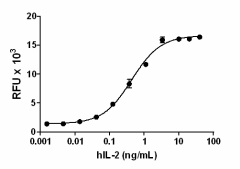- Regulatory Status
- RUO
- Other Names
- T-cell growth factor (TCGF), Eosinophil differentiation factor (EDF), Killer cell helper factor (KHF), Macrophage-activating factor for cytotoxicity I (MAF-C I), Thymocyte differentiation factor (TDF)

-

Recombinant Human IL-2 induces the proliferation of mouse HT-2 cells in a dose-dependent manner. The ED50 for this effect is 0.2 – 1.0 ng/mL.
| Cat # | Size | Price | Quantity Check Availability | ||
|---|---|---|---|---|---|
| 589102 | 10 µg | $147.00 | |||
| 589104 | 25 µg | $265.00 | |||
| 589106 | 100 µg | $698.00 | |||
| 589108 | 500 µg | $2226.00 | |||
IL-2 was discovered through its function as a T cell growth factor (TCGF), and plays a pivotal role in immune responses against pathogenic infection. Recognition and binding of the foreign Ags by the TCRs stimulate both the secretion of IL-2 and the expression of IL-2Rs on the T cell surface. Subsequently, the IL-2/IL-2R interaction activates the intracellular Ras/Raf/MAPK, JAK/STAT, and PI3K/AKT signal pathways, and ultimately stimulates the growth, differentiation, and survival of the Ag-selected cytotoxic T cells. Human IL-2 acts on murine and human T cells, and its receptors are shared by others cytokines. IL-2Rα is an IL-2–specific receptor, IL-2Rβ is shared with IL-15 and the γ chain that is a common receptor shared by many cytokines including IL-2, IL-4, IL-7, IL-9, IL-15, and IL-21.
Product Details
- Source
- Human IL-2, amino acids Ala21-Thr153 (Accession # NM_000586), was expressed in insect cells.
- Molecular Mass
- The 133 amino acid recombinant protein (Ala21-Thr153) has a predicted molecular mass of 15418 Da. The DTT-reduced and the non-reduced protein migrate at approximately 15 kD by SDS-PAGE. The N-terminal amino acid is Ala.
- Purity
- Purity is >95%, as determined by Coomassie stained SDS-PAGE.
- Formulation
- The protein was 0.22 µm filtered protein solution is in 0.1% TFA, 30% acetonitrile.
- Endotoxin Level
- Less than 0.01 ng per µg cytokine as determined by the LAL method.
- Concentration
- 10 and 25 µg sizes are bottled at 200 µg/mL. 100 µg size and larger sizes are lot-specific and bottled at the concentration indicated on the vial. To obtain lot-specific concentration and expiration, please enter the lot number in our Certificate of Analysis online tool.
- Storage & Handling
- Unopened vial can be stored between 2°C and 8°C for up to 2 weeks, at -20°C for up to six months, or at -70°C or colder until the expiration date. For maximum results, quick spin vial prior to opening. The protein can be aliquoted and stored at -20°C or colder. Stock solutions can also be prepared at 50 - 100 µg/mL in appropriate sterile buffer, carrier protein such as 0.2 - 1% BSA or HSA can be added when preparing the stock solution. Aliquots can be stored between 2°C and 8°C for up to one week and stored at -20°C or colder for up to 3 months. Avoid repeated freeze/thaw cycles.
- Activity
-
The ED50 = 0.05 – 0.3 ng/mL as determined by the dose-dependent stimulation of CTLL2 cell proliferation. The ED50 = 0.2 – 1.0 ng/mL as determined by the dose-dependent stimulation of HT-2 cell proliferation.
The specific activity of recombinant human IL-2 is approximately 2.36 x 104 IU/μg when compared against the 2nd WHO International Standard for Human IL-2 (NIBSC code: 86/500) as determined by dose-dependent stimulation of HT-2 cell proliferation.
For more information on specific activity, please visit the Recombinant Protein Unit Conversions page. - Application
-
Bioassay
- Application Notes
-
This IL-2 protein is biologically active and can be used for in vitro assays.
BioLegend carrier-free recombinant proteins provided in liquid format are shipped on blue-ice. Our comparison testing data indicates that when handled and stored as recommended, the liquid format has equal or better stability and shelf-life compared to commercially available lyophilized proteins after reconstitution. Our liquid proteins are verified in-house to maintain activity after shipping on blue ice and are backed by our 100% satisfaction guarantee. If you have any concerns, contact us at tech@biolegend.com. -
Application References
(PubMed link indicates BioLegend citation) -
- Wingender G, et al. 2011. J. Exp. Med. 208:1151. PubMed
- Product Citations
-
Antigen Details
- Structure
- Cytokine
- Distribution
-
Activated T cells
- Function
- IL-2 works in vivo to promote clonal T-cell expansion during immune responses. IL-2 stimulates the growth, differentiation, and survival of the Ag-selected cytotoxic T lymphocytes (CTLs). In addition, IL-2 regulates facilitate the proliferation and the synthesis of immunoglobulin by B cells, induces the generation and persistence of natural killer (NK) cells. Also, IL-2, through its role in activation-induced cell death (AICD) and its participation in the maintenance of peripheral CD4+CD25+ regulatory T (TReg) cells, is involved in the elimination of self-reactive T cells, which have a role in the pathogenesis of autoimmune diseases.
- Interaction
- T cells, B cells, NK cells, LAK cells, monocytes, macrophages, oligodendrocytes
- Ligand/Receptor
- IL-2R is composed of three subunits, IL-2R alpha (p55, Tac Ag, or CD25), IL-2R beta (p75 or CD122), and the γc chain (p65 or CD132).
- Cell Type
- Embryonic Stem Cells, Hematopoietic stem and progenitors
- Biology Area
- Immunology, Stem Cells
- Molecular Family
- Cytokines/Chemokines
- Antigen References
-
1. Smith KA. 1988. Science 240:1169.
2. D’Cruz LM, et al. 2005. Nature Immunol. 6:1152.
3. Maloy KJ, et al. 2005. Nature Immunol. 6:1071.
4. Waldmann TA. 2006. Nature Rev. Immunol. 6:595.
5. Ma A, et al. 2006. Annu. Rev. Immunol. 24:657.
6. Du J, et al. 2010. J. Immunol. 184:1361. - Gene ID
- 3558 View all products for this Gene ID
- UniProt
- View information about IL-2 on UniProt.org
